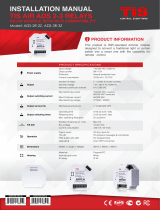
i190-00587-02 Rev. E
Garmin GTS Traffic Systems
AVIATION LIMITED WARRANTY
All Garmin avionics products are warranted to be free from defects in materials or workmanship for the
earlier of: 2 years or 800 flight hours from the date of purchase for new TSO remote-mount and TSO
panel-mount products; 1 year or 400 flight hours from the date of purchase for new Non-TSO remote-
mount* and Non-TSO panel-mount*, portable products and any purchased newly-overhauled products;
6 months or 200 flight hours for factory repaired or newly-overhauled products exchanged through a
Garmin Authorized Service Center. Within the applicable period, Garmin will, at its sole option, repair or
replace any components that fail in normal use. Such repairs or replacement will be made at no charge
to the customer for parts or labor, provided that the customer shall be responsible for any transportation
cost. This Limited Warranty does not apply to: (i) cosmetic damage, such as scratches, nicks and dents; (ii)
consumable parts, such as batteries, unless product damage has occurred due to a defect in materials or
workmanship; (iii) damage caused by accident, abuse, misuse, water, flood, fire, or other acts of nature
or external causes; (iv) damage caused by service performed by anyone who is not an authorized service
provider of Garmin; or (v) damage to a product that has been modified or altered without the written
permission of Garmin. In addition, Garmin reserves the right to refuse warranty claims against products or
services that are obtained and/or used in contravention of the laws of any country.
This Limited Warranty also does not apply to, and Garmin is not responsible for, any degradation in the
performance of any Garmin navigation product resulting from its use in proximity to any handset or
other device that utilizes a terrestrial broadband network operating on frequencies that are close to the
frequencies used by any Global Navigation Satellite System (GNSS) such as the Global Positioning Service
(GPS). Use of such devices may impair reception of GNSS signals.
THE WARRANTIES AND REMEDIES CONTAINED HEREIN ARE EXCLUSIVE AND IN LIEU OF ALL OTHER
WARRANTIES, WHETHER EXPRESS, IMPLIED OR STATUTORY, INCLUDING ANY LIABILITY ARISING UNDER
ANY WARRANTY OF MERCHANTABILITY OR FITNESS FOR A PARTICULAR PURPOSE, STATUTORY OR
OTHERWISE. THIS WARRANTY GIVES YOU SPECIFIC LEGAL RIGHTS, WHICH MAY VARY FROM STATE TO
STATE.
IN NO EVENT SHALL GARMIN BE LIABLE FOR ANY INCIDENTAL, SPECIAL, INDIRECT OR CONSEQUENTIAL
DAMAGES, WHETHER RESULTING FROM THE USE, MISUSE OR INABILITY TO USE THE PRODUCT OR
FROM DEFECTS IN THE PRODUCT. SOME STATES DO NOT ALLOW THE EXCLUSION OF INCIDENTAL OR
CONSEQUENTIAL DAMAGES, SO THE ABOVE LIMITATIONS MAY NOT APPLY TO YOU.
Garmin retains the exclusive right to repair or replace (with a new or newly-overhauled replacement
product) the product or software or offer a full refund of the purchase price at its sole discretion. SUCH
REMEDY SHALL BE YOUR SOLE AND EXCLUSIVE REMEDY FOR ANY BREACH OF WARRANTY.
Online Auction Purchases: Products purchased through online auctions are not
eligible for warranty coverage. Online auction confirmations are not accepted for warranty
verification. To obtain warranty service, an original or copy of the sales receipt from
the original retailer is required. Garmin will not replace missing components from any
package purchased through an online auction.























